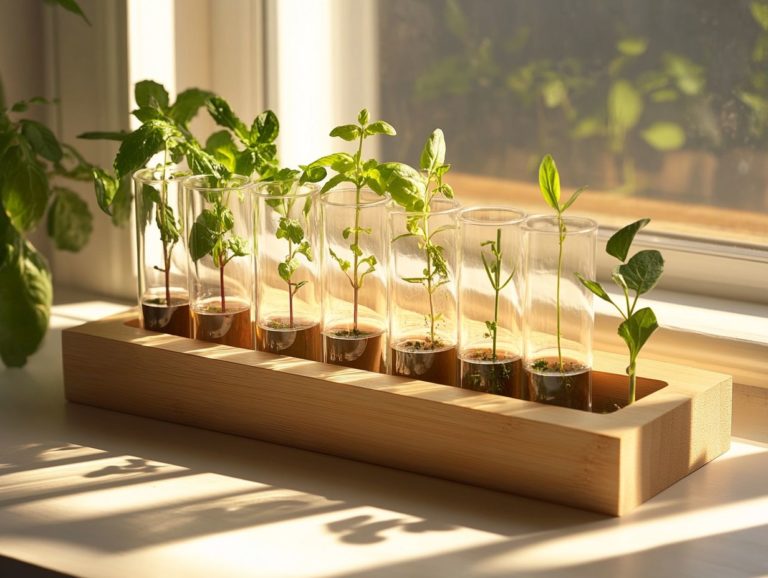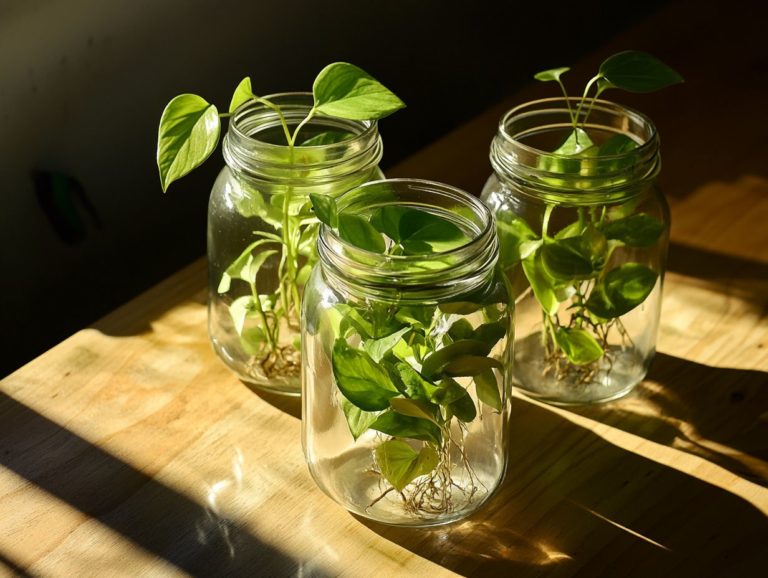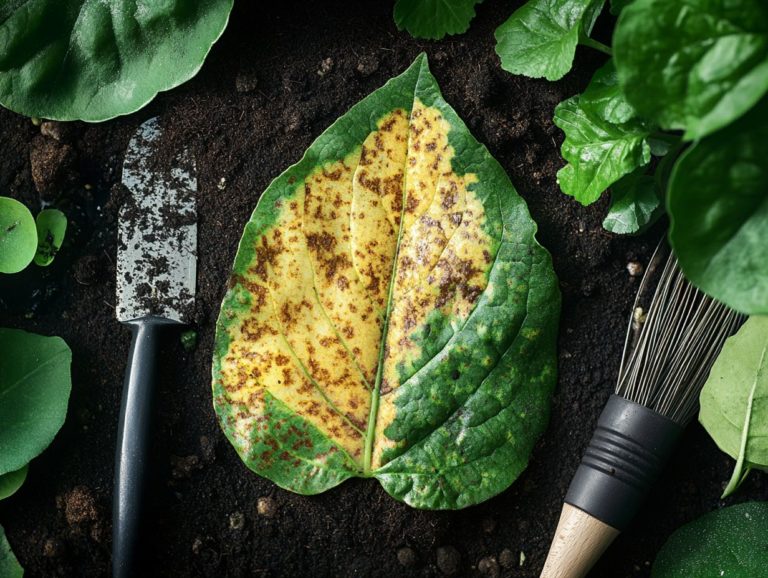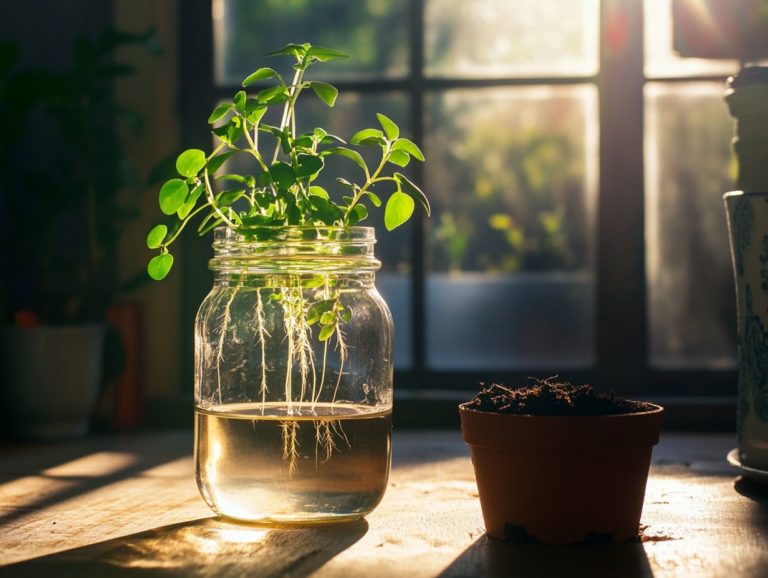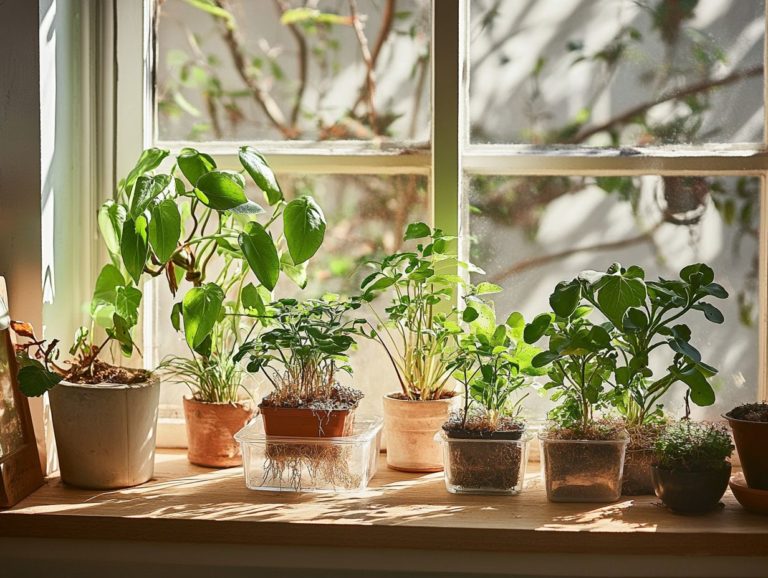How Temperature Affects Plant Propagation
Plant propagation is a captivating journey that enables you to cultivate new plants from seeds, cuttings, or even other parts of existing ones. This process enhances overall plant growth.
Your success in this endeavor hinges on several factors, with temperature being paramount. This exploration delves into how temperature impacts crucial stages such as germination, rooting, and growth. You’ll gain insights into the optimal temperature ranges and environmental factors for a variety of plants.
Whether you re an experienced gardener or just beginning your green journey, you ll discover valuable tips for managing temperature to boost your propagation success. Enhance your plant nutrition along the way!
Dive right in to discover more exciting tips!
Contents
- Key Takeaways:
- Factors Affecting Plant Propagation
- How Temperature Affects Different Stages of Propagation
- Optimal Temperature Range for Different Plants
- Tips for Controlling Temperature for Successful Propagation
- Frequently Asked Questions
- 1. How does temperature affect plant propagation?
- 2. What is the ideal temperature for plant propagation?
- 3. How does temperature affect seed germination?
- 4. Can temperature influence root formation during propagation?
- 5. How does temperature affect the overall health of propagated plants?
- 6. Can temperature affect the success rate of plant propagation?
Key Takeaways:

- Temperature plays a crucial role in plant propagation, affecting germination, rooting, and overall growth.
- Each plant has an optimal temperature range for propagation. Understanding these preferences can lead to higher success rates.
- Controlling temperature through methods like heat mats can significantly improve the success of plant propagation.
Understanding Plant Propagation
Plant propagation is the art of creating new plants from existing ones. It holds significant importance in horticulture and influences plant growth across species, including beloved flowering plants like tomatoes, cucumbers, and chrysanthemums.
By familiarizing yourself with various propagation methods like seed sowing and cuttings you can enhance crop production and preserve biodiversity. Seed propagation allows you to start plants from seeds, opening the door to genetic diversity, which can lead to different traits.
On the other hand, vegetative methods, including the use of cuttings or division, enable you to replicate specific plant traits. This ensures consistency in growth patterns.
Both methods demand careful attention to plant nutrition. Delivering the right nutrients can significantly impact germination rates and overall plant health. Mastering these techniques not only paves the way for your garden’s success but is vital for sustaining ecosystems, especially in a world that s constantly changing.
Factors Affecting Plant Propagation
Several environmental factors play a pivotal role in influencing plant propagation. Light quality, temperature variations, humidity levels, and soil nutrients are critical elements that significantly affect plant growth.
Understanding these factors is essential for managing crops effectively and maximizing plant adaptation across different conditions, particularly in response to seasonal changes.
Role of Temperature in Plant Propagation
Temperature is a critical factor in plant propagation. It influences everything from breaking dormancy to germination rates, nutrient absorption, and overall growth patterns. This impact varies significantly across different species, like spinach and poinsettia.
By mastering temperature manipulation, you facilitate effective plant adaptation and improve crop quality and yield.
During the intricate process of seed germination, optimal temperature ranges activate growth regulators that control cellular processes, including stem elongation and leaf production. This leads to healthier and more vigorous seedlings.
Excessively high or low temperatures can disrupt genetic expression and hinder normal growth cycles, creating challenging conditions for budding plants.
Relative humidity works in tandem with temperature and plays an equally vital role. Elevated moisture levels can enhance root development in warmer conditions, fostering better nutrient uptake.
By maintaining the right balance of temperature and humidity levels, you maximize germination success and promote robust root systems. This ultimately results in thriving plants that are primed for propagation.
Share your propagation journey with us below!
How Temperature Affects Different Stages of Propagation
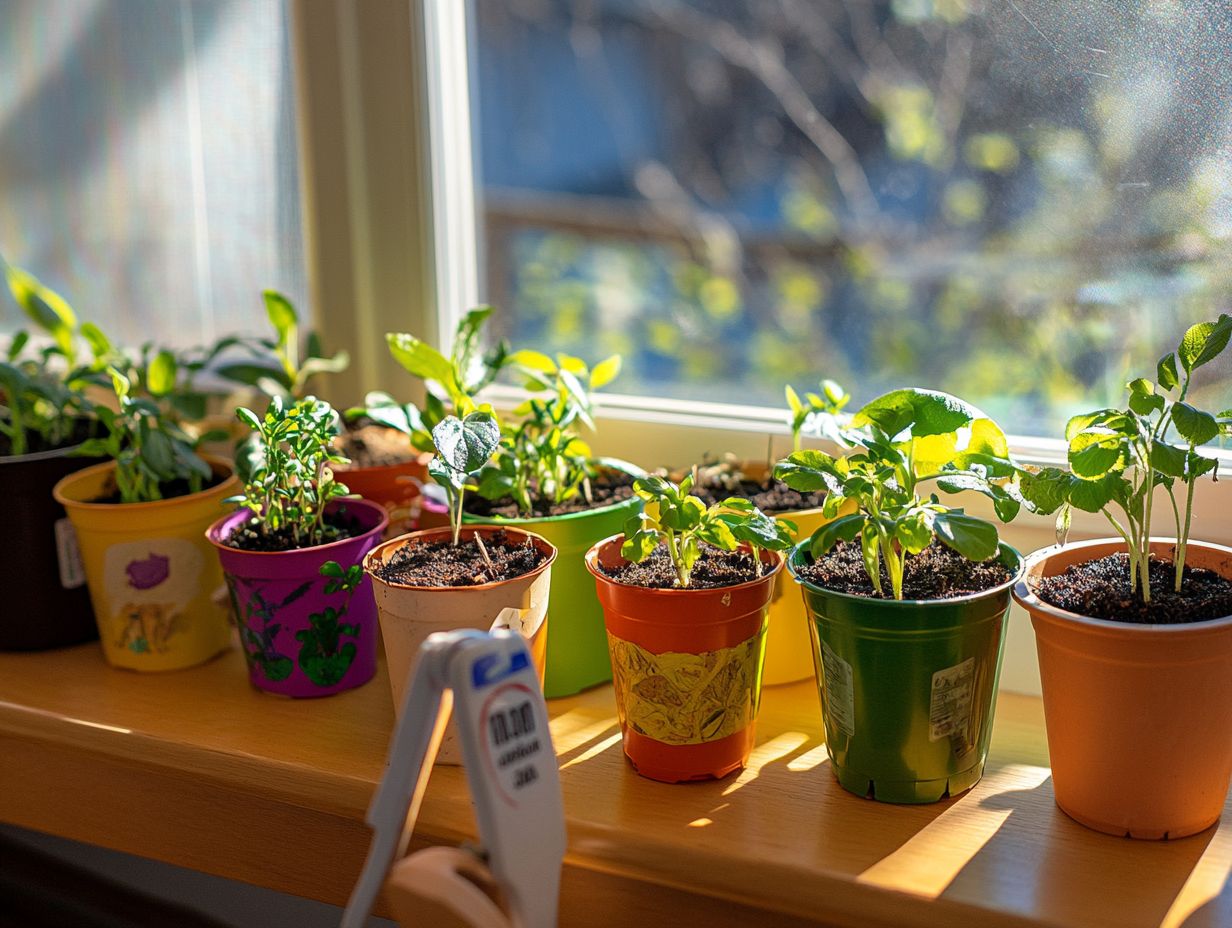
Temperature plays a vital role in plant propagation, especially during germination and rooting. Both are crucial for successful plant development.
By maintaining optimal temperature ranges, you can accelerate germination, enhance nutrient mobilization, and cultivate healthier, more resilient plants.
Germination
Germination marks the first step in plant propagation. Seeds soak up water and swell, leading to the emergence of sprouts. This process is influenced by factors such as light quality and temperature.
It’s vital to understand the specific water requirements during this phase to ensure successful growth. Moisture levels and light intensity are closely connected. Don’t overlook their impact on growth.
Insufficient moisture can lead to nutrient deficiencies that stifle growth. Your seedlings need balanced conditions to promote optimal gas exchange, ensuring oxygen reaches the developing roots and carbon dioxide levels remain in check.
Too much light can create excessive heat, drying out the soil. Conversely, too little light can slow down the sprouting process. Establish a controlled environment that emphasizes these elements to nurture strong seedlings, setting the stage for their future development.
Rooting
Rooting is an essential phase in plant propagation. The formation of roots allows plants to absorb the nutrients and water they need for growth. This delicate process is highly sensitive to environmental factors like humidity.
Understand how to enhance rooting through proper horticultural practices to impact the overall health and development of your plants. Focus on effective water management and fertilization practices.
Selecting the right rooting medium can optimize soil nutrients. Different cutting techniques can also boost your chances of successful propagation. Be mindful that environmental stressors, like drought or excessive moisture, can hinder root growth.
Create a stable environment and employ proven techniques to cultivate robust root systems that promote healthier growth patterns and elevate your plants’ vitality.
Growth and Development
The growth and development phase is essential for plant survival and productivity. Factors like light quality, nutrient sources, and temperature manipulation significantly shape this phase.
Optimize these elements to enhance plant adaptation in various habitats, determining the success of propagation and crop quality. Understanding how different light wavelengths affect growth allows you to tailor the effects of light duration on plant growth.
Macronutrients and micronutrients are essential for plant growth. They provide the necessary building blocks for cellular structures and metabolic processes.
Environmental factors like humidity and soil conditions are crucial in shaping these developmental phases. Explore growth regulators, including auxins and gibberellins, to unlock new potential for enhancing development, ensuring that plants thrive even in less-than-ideal conditions.
Optimal Temperature Range for Different Plants
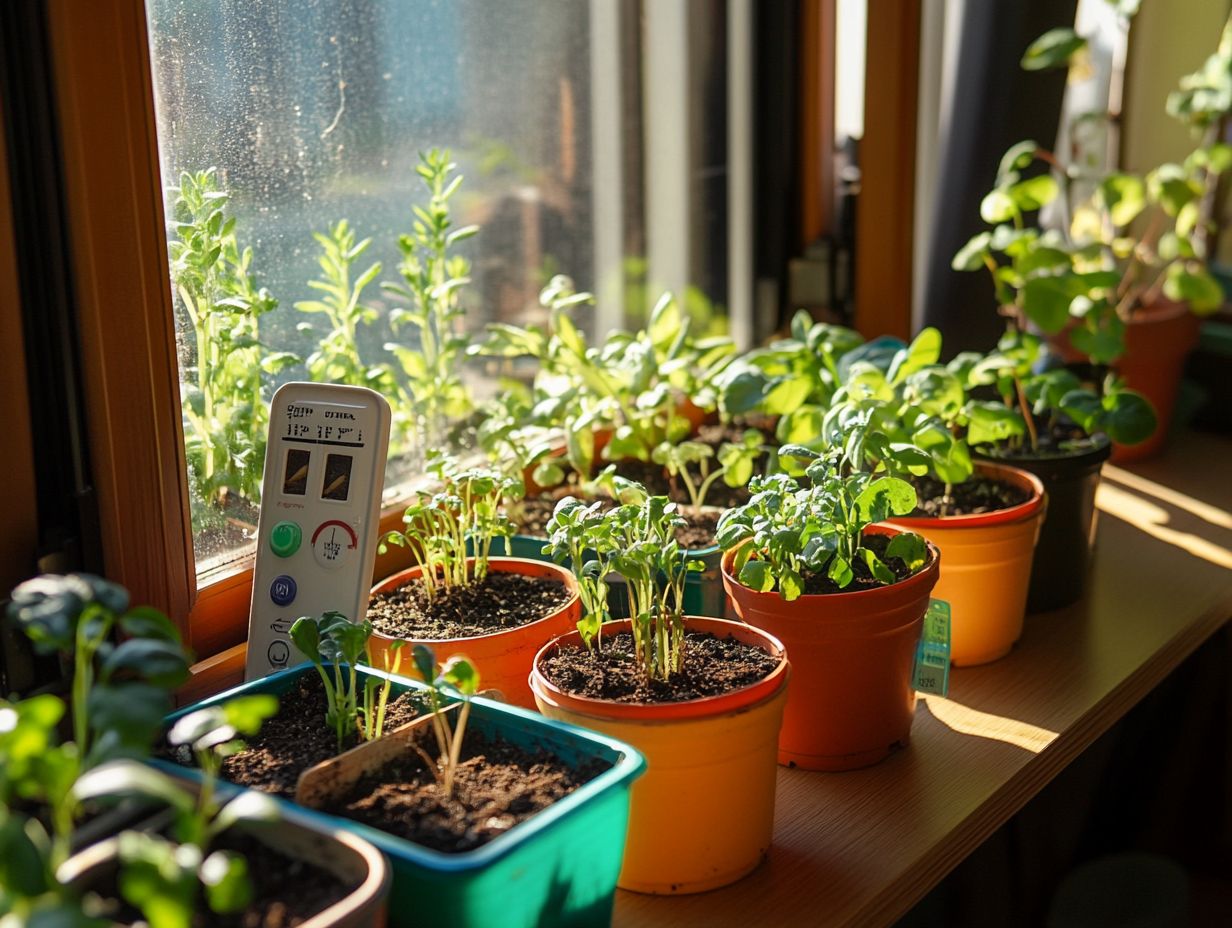
Determining the optimal temperature range for various plants is crucial for successful propagation and cultivation. Each species, whether tomatoes or cucumbers, has its specific temperature needs that profoundly influence growth and productivity.
By grasping these classifications, you can enhance your crop management strategies and achieve superior production outcomes.
Start optimizing your plant’s environment today for healthier growth!
Examples of Plants and Their Preferred Temperatures
Different plants have their own preferred temperature ranges that dictate how they grow and develop. For instance, tomatoes thrive in warm climates, while spinach prefers cooler conditions. Understanding these preferences is essential for employing effective horticultural techniques that optimize both crop quality and yield.
Consider plants like cucumbers and tomatoes, which flourish between 70 F and 95 F. In contrast, kale can tolerate temperatures as low as 20 F. It’s crucial to adjust your propagation strategies to prevent nutrient deficiencies. Understanding the science behind plant propagation shows how these specific temperature ranges influence nutrient absorption and play a pivotal role in flowering control, ensuring that your plants develop at their best.
Managing greenhouse temperatures and understanding light duration to create a stable environment for sensitive varieties can lead to healthier plants and a more robust yield. Additionally, recognizing the impact of humidity on plant propagation can further improve your success. By planning your planting schedules around these temperature ranges, you can enhance your crop resilience and productivity.
Tips for Controlling Temperature for Successful Propagation
Controlling temperature is essential for successful propagation. Techniques like utilizing heat mats and fine-tuning humidity levels can improve conditions for plant growth, promoting better nutrient absorption, enhancing photosynthesis rates, and overall plant health.
Implementing effective water management strategies is vital for achieving ideal temperatures, ensuring your plants thrive in their optimal environment.
Using Heat Mats and Other Methods
Heat mats are an effective way to control temperature during plant propagation. They provide consistent warmth, significantly enhancing germination rates and fostering early growth in your crops. This approach can improve crop quality and expedite how quickly your plants adapt to their environment.
By keeping soil temperatures optimal, heat mats promote better water absorption and nutrient uptake, ensuring that your seedlings have everything they need to thrive. These mats are particularly advantageous during the initial stages of propagation, as they help prevent the environmental stress caused by temperature fluctuations, which is crucial for understanding the influence of temperature on propagation success.
If you’re interested in alternative methods, consider tactics like row covers or thermal blankets. They provide supplemental warmth without the intense heat of direct sunlight. These strategies also manage moisture levels, keeping your plants happy through critical growing phases, and offering you a versatile approach to achieving healthy, robust growth.
Frequently Asked Questions
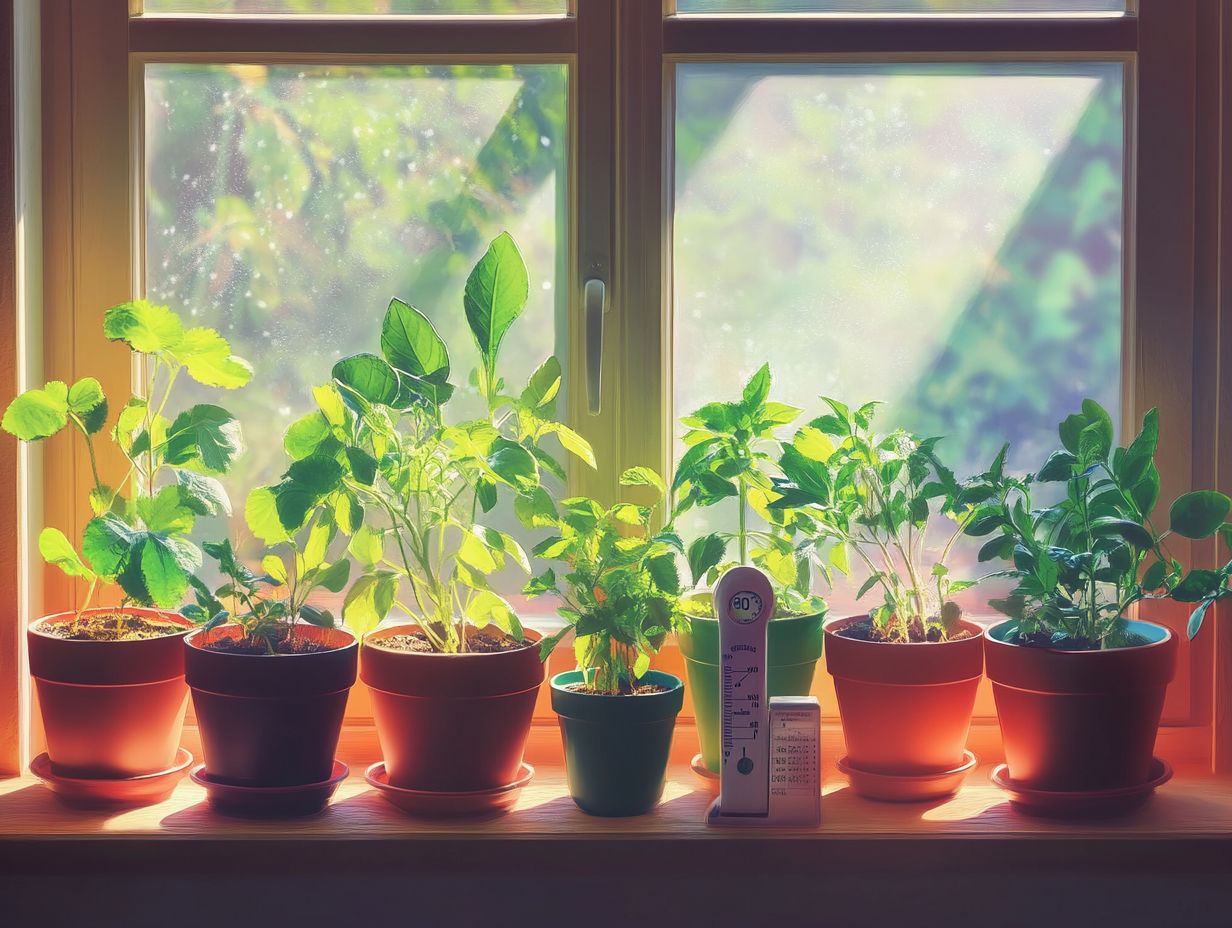
1. How does temperature affect plant propagation?
The temperature plays a crucial role in the success of plant propagation as it affects processes such as seed germination, root formation, and overall plant health.
2. What is the ideal temperature for plant propagation?
The ideal temperature varies depending on the plant type, but generally, a range of 65 F to 75 F is considered optimal. Some plants may require slightly higher or lower temperatures, so it’s important to research the specific needs of your chosen plant for successful propagation.
3. How does temperature affect seed germination?
Temperature directly affects the rate of seed germination. Most seeds require a specific temperature range to break dormancy and start germinating. If the temperature is too low, germination may be delayed or inhibited, while high temperatures can damage the seeds.
4. Can temperature influence root formation during propagation?
Yes, temperature significantly impacts root formation during propagation. Higher temperatures can stimulate root growth, while lower temperatures may slow it down or inhibit it. Keeping the right temperature is crucial for thriving plants!
5. How does temperature affect the overall health of propagated plants?
Temperature greatly influences the health of propagated plants. Extreme fluctuations can stress plants, making them more likely to get sick or attract bugs.
Consistently low or high temperatures hinder growth. This results in weaker, less vigorous plants.
6. Can temperature affect the success rate of plant propagation?
Absolutely! Temperature plays a huge role in the success of plant propagation.
Inadequate temperatures can lead to poor germination and unhealthy roots. To ensure your plants thrive, keep a close eye on the temperature!

